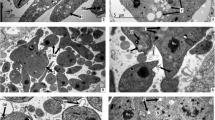Summary
Development of Eimeria vermiformis from sporozoite to mature first-generation schizonts in cultured bovine kidney cells, Madin-Darby bovine kidney cells, and primary cultures of whole mouse embryos is described. Intracellular sporozoites were seen at 5 min, and for as long as 120 h after inoculation. Sporozoites were observed penetrating cells, with uninucleate trophozoites and immature schizonts with 2–6 nuclei first appearing 24 h after inoculation. Schizonts with 6 or more nuclei, as well as mature schizonts containing first-generation merozoites, were first seen between 36 and 48 h after inoculation of all 3 cell types used. The first indication of merozoite formation was determined by the appearance of small protuberances of cytoplasm at the periphery of schizonts. Merozoites began development at the periphery of schizonts and were later observed radiating from a central body of cytoplasm, 14–20 merozoites being formed. Some mature schizonts retained a small spherical residual body after merozoite formation was completed. After the rupture of schizonts, intracellular merozoites, which contained anterior and posterior refractile granules, were seen at 48, 72 and 96 h postinoculation. Merozoites were not seen entering or leaving cells. No further development was observed.
Similar content being viewed by others
References
Černa, Z., Sénaud, J.: Eimeria pragensis sp. n., a new coccidian parasite from the intestine of mice (Mus musculus). Folia parasit. 16, 171–175 (1969)
Fayer, R., Hammond, D.M.: Development of first-generation schizonts of Eimeria bovis in cultured cells. J. Protozool. 14, 764–772 (1967)
Haberkorn, A.: Die Entwicklung von Eimeria falciformis (Eimer 1870) in der weißen Maus (Mus musculus). Z. Parasitenk. 34, 49–67 (1970)
Kelley, G.L., Hammond, D.M.: Development of Eimeria ninakohlyakimovae from sheep in cultured cells. J. Protozool. 17, 340–349 (1970)
Müller, B.E.G., Hammond, D.M., Scholtyseck, E.: In vitro development of first- and second-generation schizonts of Eimeria contorta Haberkorn, 1971 (Coccidia, Sporozoa). Z. Parasitenk. 41, 173–185 (1973)
Speer, C.A., Hammond, D.M.: Development of Eimeria laramerensis from the Uinta ground squirrel in cell cultures. Z. Parasitenk. 35, 105–118 (1970)
Speer, C.A., Hammond, D.M., Anderson, L.C.: Development of Eimeria callospermophili and E. bilamellata from the Uinta ground squirrel, Spermophilus armatus, in cultured cells. J. Protozool. 17, 274–284 (1973)
Todd, K.S., Jr., Lepp, L.: The life cycle of Eimeria vermiformis Ernst, Chobotar and Hammond 1971 in the mouse, Mus musculus. J. Protozool. 18, 332–337 (1971)
Author information
Authors and Affiliations
Rights and permissions
About this article
Cite this article
Kelley, G.L., Youssef, N.N. Development in cell cultures of Eimeria vermiformis Ernst, Chobotar and Hammond, 1971. Z. F. Parasitenkunde 53, 23–29 (1977). https://doi.org/10.1007/BF00383111
Received:
Issue Date:
DOI: https://doi.org/10.1007/BF00383111




